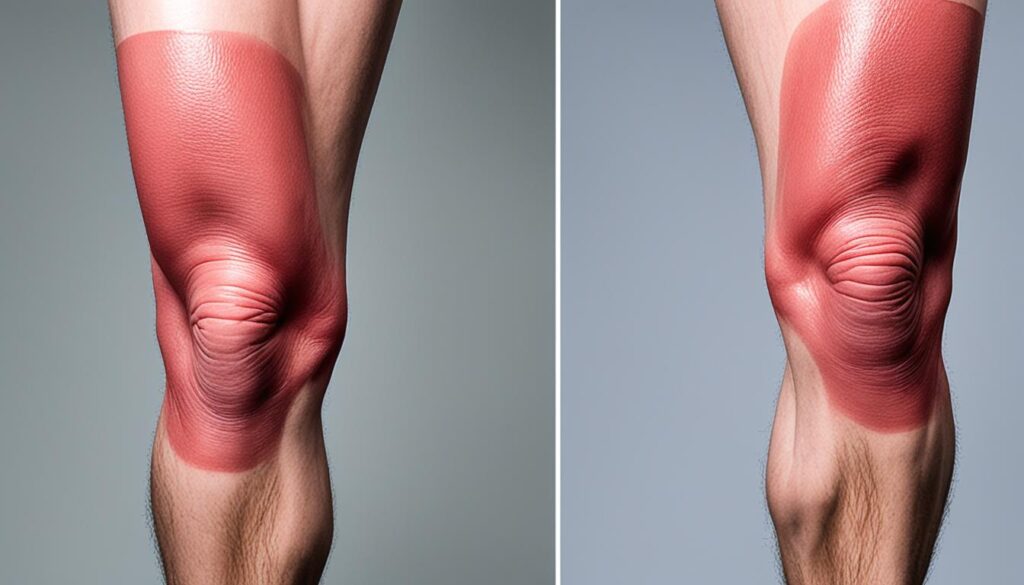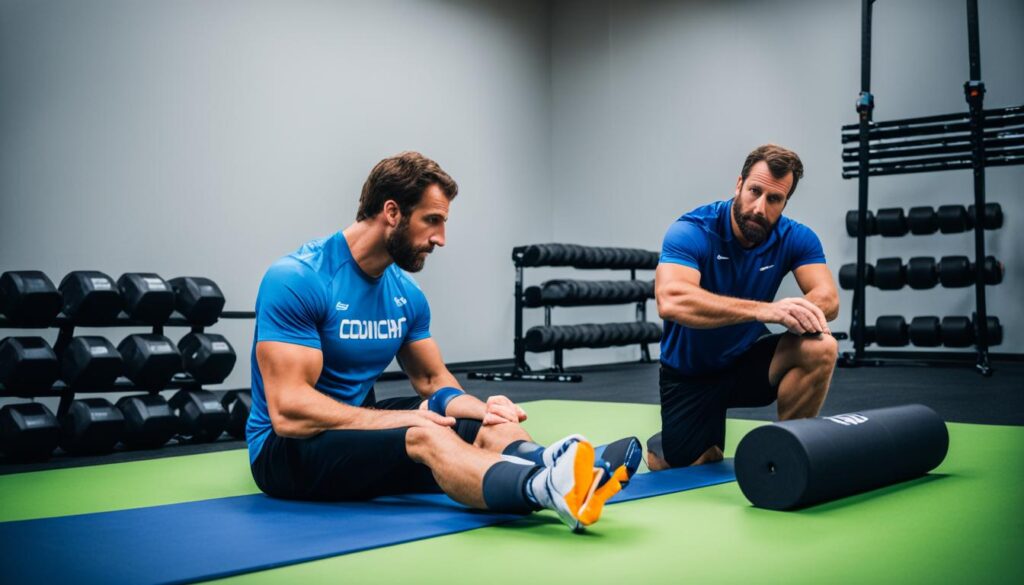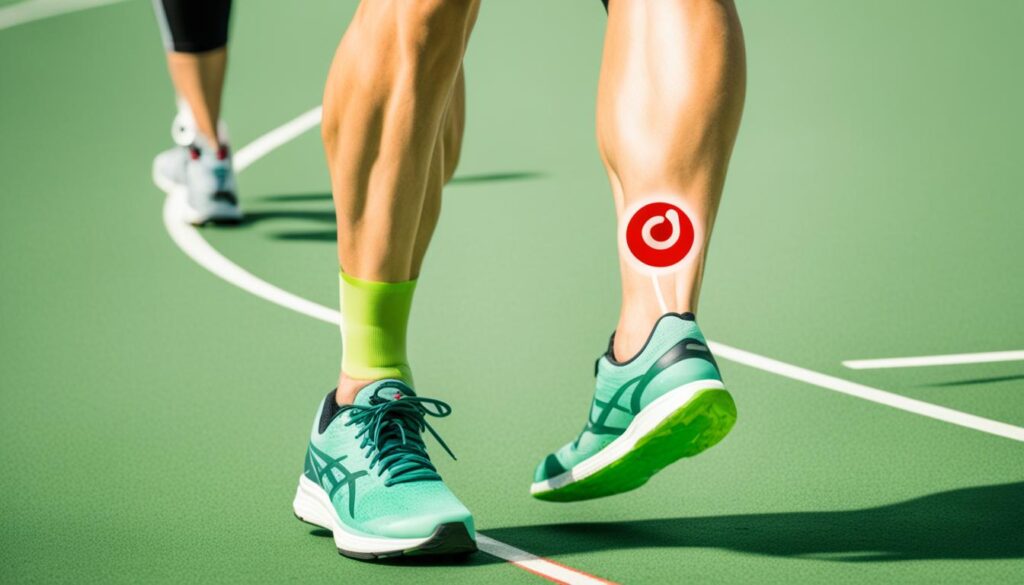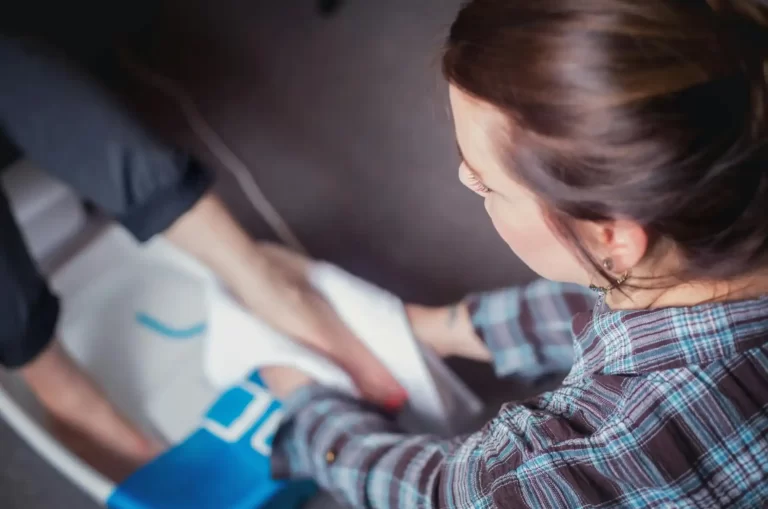Dealing with Shin Splints: Causes, Symptoms, and Treatment
Shin splints can put athletes out of action for about 6 months, show recent studies. They are known as medial tibial stress syndrome. This affects people like runners, dancers, and those in the military who up their training’s intensity. The ongoing stress on the shinbone and its tissues causes pain and swelling, risking stress fractures if not treated.
When lower leg muscles and bones get irritated, it’s called shin splints. This happens from too much stress on the legs, common in athletes and those in the military. This stress causes a lot of pain. Without care, it could lead to serious issues like stress fractures.
It’s key for athletes, active people, and doctors to know about shin splints. Acting fast and taking steps to prevent it can lower the risks. This helps people get back to their normal activities quicker.
### Key Takeaways
– Shin splints are a common overuse injury affecting the lower leg muscles, tendons, and bones.
– Risk factors include sudden increases in exercise intensity or duration, running on hard surfaces, and having flat or inflexible feet.
– Symptoms include pain, tenderness, and swelling along the shinbone.
– Treatment often involves rest, ice, anti-inflammatory medication, and gradual rehabilitation.
– Preventive strategies include proper footwear, gradual training progression, and strengthening exercises.
– Seeking prompt medical attention and following a comprehensive treatment plan can help facilitate a full recovery.
What are Shin Splints?
Shin splints cause pain along the shinbone or tibia. They happen because of overuse. This happens when your leg’s muscles, tendons, and bones get inflamed from too much stress.
Definition and Explanation
Shin splints are like a common ache in your lower leg’s tibial bone. Athletes, runners, and military folk often feel this. It comes when you start working out more, making your muscles and bones ache.
Types of Shin Splints
Shin splints come in three types: anterior, medial, and posterior. Each type causes pain in different leg spots, showing where it forms:
| Type | Location of Pain |
|---|---|
| Anterior Shin Splints | Front of the lower leg, along the tibial bone |
| Medial Shin Splints | Inside of the lower leg, along the tibial bone |
| Posterior Shin Splints | Back of the lower leg, along the tibial bone |
Shin Splints vs. Stress Fractures
Shin splints and stress fractures are not the same. Shin splints come from too much activity and cause inflammation. But stress fractures are tiny breaks in the bone, needing more care and time to heal.
Symptoms of Shin Splints
Shin splints cause leg pain and shin bone pain. They also bring lower leg discomfort. These issues happen with exercise-induced pain. They are linked to tibialis muscle pain. People with shin splints find their daily life and exercise tough.
Pain and Discomfort
Shin splint symptoms often start with shin bone pain. This pain is sharp, dull, or aching. It’s right in the front or outer parts of the lower leg. The pain gets worse when you’re active. It can happen when your heel hits the ground hard, like when you run. Over time, the pain can keep hurting. And the area might feel sore if you touch it.
Swelling and Inflammation
Shin splints also show shin swelling. Plus, they cause shin inflammation. This lower leg discomfort can be light or very bad. It might get worse when you keep moving. Sometimes, you can see a bulge or swelling on the front or inside of the shin.

Causes and Risk Factors of Shin Splints
Shin splints happen when you use your legs too much and stress the muscles and bones. Risk factors include:
Overuse and Repetitive Stress
Doing lots of running, dancing, or military work can overuse your shins. This can cause shin splints. If you start to exercise more suddenly, you might get this injury.
Exercise Intensity and Frequency
Adding too much exercise too quickly can be bad for your legs. You should slowly increase how much you run or workout. Keep it to no more than 10% more each week to avoid shin splints.
Footwear and Surfaces
Bad shoes or running on hard surfaces like concrete can also cause shin splints. People with flat feet or high arches are more at risk. This is because their shoes might not support or cushion their feet enough.
Individual Factors
Issues like muscle imbalances or certain body shapes can make shin splints more likely. If your ankles, hips, or core are weak, you might get these injuries easier.
shin splints
Shin splints are a common overuse injury. They affect the lower leg’s muscles, tendons, and bones. When you have shin splints, you feel pain, tenderness, and swelling on your shinbone. This happens during or after physical activities.
Repetitive stress on the shinbone and its tissues can cause shin splints. This is seen in runners, athletes, and military personnel. It happens when you suddenly increase how long, how often, or how hard you train.
The risk of getting shin splints goes up if you suddenly work out harder or longer. Running on hard surfaces, having flat feet or high arches, and military training also increase this risk. Wearing the right shoes and making small, gradual changes in your activity level can lower the chance of getting shin splints.

Shin splints are common but can be managed. Rest, ice, and taking care of yourself are key. Understanding how to prevent this overuse injury keeps your active life healthy. It helps avoid shin splints and the pain they bring.
Diagnosis and Testing
To find out if someone has shin splints, doctors start by checking their legs. They look for swelling, tenderness, and how well the leg moves. This helps them see if it’s really shin splints.
Physical Examination
Doctors ask about the patient’s past and their exercise habits. They touch the shinbone to see where it hurts. Checking how the patient walks and moves helps tell if it’s shin splints or something else.
Imaging Tests
If it seems like shin splints, more tests might be done. X-rays, bone scans, or MRIs can show the inside of the leg. These tests help doctors make sure of the diagnosis and check for other problems.
Treatment and Management
Shin splints treatment focuses on easing pain and swelling. It also aims to let the tissues heal well. Common methods do not involve surgery. Instead, they start with simple steps.
Rest and Recovery
Rest and recovery are key in treating shin splints. Stop or cut back on activities like running or dancing. This is important for the injured leg to heal.
Ice and Compression
Using ice on the shin helps with inflammation and pain. Icing for 15-20 minutes several times a day is good. Compression also reduces swelling and gives support.
Medication and Pain Relief
Anti-inflammatory medicines like Advil or Aleve can ease pain and swelling. These NSAIDs lessen inflammation and help you feel better while healing.
Physical Therapy and Exercises
After the pain goes down, a physical therapist can teach you exercises. These exercises focus on stretching and strengthening. They target the legs and other key areas to make you strong, balanced, and flexible.

A mix of rest, ice, compression, meds, and therapy helps beat shin splints. With these, you can safely get back to your active life.
Prevention Strategies
To avoid shin splints, you should take many steps. Doing so reduces your chance of getting this common injury. Here’s what you need to follow:
Proper Footwear and Insoles
Choose well-fitted athletic shoes. They should have shock-absorption and arch support. Using insoles is also great for protecting your shinbone and leg muscles. Change your shoes when they wear out and make sure they fit you well to help avoid shin splints.
Gradual Increase in Exercise
It’s important to slowly up your physical activity’s time, how often you do it, and how hard. Fast increases can strain your lower legs too much and cause shin splints. So, step up your exercise level slowly.
Cross-Training and Variety
Add activities like swimming, cycling, or using an elliptical to your routine. Doing this can lower the stress on your legs. Changing up your exercises and the surfaces you use also helps ward off shin splints.
Strength and Flexibility Training
Building up your foot and hip muscles is beneficial as they absorb shock. This lessens your shin splint risk. Regular flexibility training for your calves, shins, and Achilles helps your joints and muscles stay in top shape. This makes you less likely to get hurt.
Returning to Activity
After beating shin splints with a good rest, ice, and other tips, it’s time to get active again. Start slowly to avoid shin splints coming back. This way, you can safely get back to your usual workouts.
Gradual Reintroduction
Returning to activity after shin splints means beginning with easy exercises. Things like walking, cycling, or swimming are great choices. They’re gentle on your shins. Work with your doctor or therapist to create a plan that fits your needs. They will guide you to increase activity safely.
Monitoring Pain and Symptoms
Take it slow and watch how you feel as you get back into it. If you feel sharp or lasting pain in your shins, stop and get help. Don’t ignore the pain, it could make things worse. Listening to your body can help you avoid setbacks.

Special Considerations
Shin splints can happen to anyone who is active. Yet, some people are more likely to get them. Athletes, runners, and military folks often face this problem more than others.
Athletes and Runners
Sports like running, basketball, and dance can be tough on the legs. This makes athletes and runners extra at risk for shin splints. The hard pounding and quick changes in movement stress the lower legs. Things like bad shoes, muscles that are not balanced, and sudden heavy training can also cause shin splints.
Military Personnel
Those in the military are more likely to get shin splints too. Their tough training and duties, which may involve marching with heavy gear, put a real strain on their legs. This, alongside bad footwear, fast training gains, and the hard impact of their work, ups their chances of getting shin splints.
To avoid shin splints and other leg issues, slow training increases are key. Doing exercises to build strength and being flexible also helps a lot. Plus, wearing the right shoes is very important. This advice is for athletes, runners, and military personnel aiming to stay injury-free. It helps them keep up with their active lives.
Conclusion
Shin splints, also known as medial tibial stress syndrome, are common. They cause pain, tenderness, and swelling along the shinbone. People who run, play sports, or are in the military often get this condition.
It’s key to deal with the causes to stop shin splints. This includes wrong shoes, too much exercise, and body imbalances. Gradually increasing exercise, building strength, and using good shoe inserts can lower the risk.
When shin splint signs show up, quick care is needed. This means resting, putting ice, applying compression, and doing rehab exercises. Handling the issue fast and with a good plan lets people safely come back to their activities. It also cuts the chance of getting stress fractures or worse later on.







